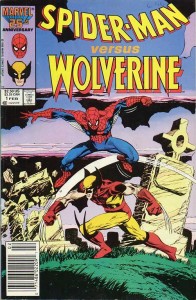 Wolverine has always been a complicated character for me to have a reader-relationship with – and that’s just par for the course for a mysterious anti-hero whose entire shtick is predicated on the fact that he’s an incredibly difficult nut to crack. But for me, the complications stem from the fact that I’ve always been a Spider-Man fan and I’ve always perceived Wolverine to be on the opposite end of the philosophical spectrum from my friendly neighborhood Web Slinger. Being a hardcore fan of both would seemingly fly in the face of basic logic. At least that’s what I used to think until I read the Spider-Man vs. Wolverine graphic novel from 1987 by Jim Owsley (script) and Mark Bright (pencils).
Wolverine has always been a complicated character for me to have a reader-relationship with – and that’s just par for the course for a mysterious anti-hero whose entire shtick is predicated on the fact that he’s an incredibly difficult nut to crack. But for me, the complications stem from the fact that I’ve always been a Spider-Man fan and I’ve always perceived Wolverine to be on the opposite end of the philosophical spectrum from my friendly neighborhood Web Slinger. Being a hardcore fan of both would seemingly fly in the face of basic logic. At least that’s what I used to think until I read the Spider-Man vs. Wolverine graphic novel from 1987 by Jim Owsley (script) and Mark Bright (pencils).
In another example of how the Marvel Unlimited app for my iPad has changed my life as a comic book enthusiast – I recently got to experience this story for the first time after a reader, responding to an article I wrote for Sequart about Spider-Man’s “no-kill code,” reminded me of its existence. Published in early 1987 (which actually means late 1986), the graphic novel was the follow-up to the “Gang War” arc that ended at Amazing Spider-Man #288 (and set up what ended up being one of the most bizarre moments in comic book history when in ASM #289 the Hobgoblin is revealed to be Ned Leeds – a character who had just been killed off in this graphic novel). As many of my long-time readers will note, I didn’t start reading Spider-Man comics until ASM #296, so with a few exceptions, Spider-Man events that took place outside the confines of ASM before #296 remain a major blind spot for me.
I’m glad this reader mentioned Spider-Man vs. Wolverine because it’s probably the most well-crafted team-up story I can think of involving Spider-Man. Spidey and Wolverine get equal-billing in this title, and for good reason. Owsley writes an incredibly intelligent character study demonstrating how Spidey and Logan aren’t as far from each other on the superhero philosophy tree as I originally thought – and this is all done in a way that doesn’t betray who these characters are (of course, I’m speaking more for Spider-Man here. If there are Wolverine fans out there that are really upset by the portrayal, I’d love to hear your complaints).
A sequence that immediately struck me was Peter Parker’s opening monologue/narrative about his photography. Peter describes himself almost as if he’s a soulless mercenary – who financially benefits from taking photos of other people’s misery. I honestly never thought about Peter’s photography from that angle before, and while I’ll admit I was initially flummoxed when I read this passage, after taking some time to reflect on it, it makes total sense to me. Peter’s guilt about everything he does causing pain and misfortune on others has long been a common storytelling devices for Spider-Man writers, so of course he would think this way about his photography. By being so disconnected and unemotional about it, it keeps him from shaming himself and feeling disgusted. That kind of sounds like the personality of a certain adamantium-laced mutant, right?
The similarities between Spidey and Wolverine are further captured (and emblemized) as the story transitions from the familiar and comfortable confines of New York City to the cold and disengaged world of Germany, where the Iron Curtain of Communism would remain fully erect for a few more years before that big old wall came tumbling down in 1990. At this point in time, Germany was a country divided, but this division was a manmade one that had been manufactured by larger political forces. At various points in this story, Wolverine tells Peter he’s “in over his head” and that he’s not cut out to try and report on the mystery of “Charlie,” with Ned. But these assumptions from Wolverine are based predominantly on his preconceptions as to who Spider-Man is. Wolverine’s enhanced senses are able to instantly connect Peter Parker’s presence in Germany with his secret identity as Spider-Man, but that doesn’t mean Wolverine really knows anything about Spider-Man/Peter’s character and what he’s capable of doing given certain circumstances.
The dark direction Spider-Man is doomed to take in this story is further advanced by the “off-camera” murder of Ned. In my recent write-up of ASM #238, I talked about legitimately “shocking” moments in Spider-Man history, and I would add Ned’s murder to the short list. It’s such a sudden, shallow ending for a character that has been around in continuity since the early 1960s, and the fact that the reader never actually sees the act committed only adds to its horror. But Ned’s murder is critical in establishing just how far from home Peter is, and the way it’s revisited by the end of this issue is a total gut-punch for Peter and the reader.
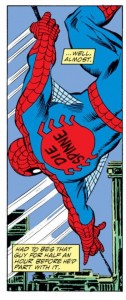 After Ned’s demise, Peter decides it’s time to move off his assignment for the Daily Bugle and embrace his superhero identity as Spider-Man. Of course, he doesn’t have a costume with him, and in a moment of phenomenal comedy, he has to buy a red and blue costume from the shopkeeper, complete with “Spider-Man” written in German on the back. So even when he’s ready to become Spider-Man, Peter is really just a cheap imitation of the character in Germany. How great is it that Owsley and Bright were even able to use a light-hearted moment to keeping advancing the theme of this story? The further Peter strays from the core tenants of being Spider-Man, the more inevitable the ending of this story becomes.
After Ned’s demise, Peter decides it’s time to move off his assignment for the Daily Bugle and embrace his superhero identity as Spider-Man. Of course, he doesn’t have a costume with him, and in a moment of phenomenal comedy, he has to buy a red and blue costume from the shopkeeper, complete with “Spider-Man” written in German on the back. So even when he’s ready to become Spider-Man, Peter is really just a cheap imitation of the character in Germany. How great is it that Owsley and Bright were even able to use a light-hearted moment to keeping advancing the theme of this story? The further Peter strays from the core tenants of being Spider-Man, the more inevitable the ending of this story becomes.
In terms of aptly juxtaposing Spider-Man and Wolverine, the scene with Logan and Charlie in the restaurant is a great sequence. For one, the reader gets a dose of Wolverine – this unusual and unpredictable character – enjoying a moment of serene normalcy despite the imminent danger that surrounds him and his girlfriend. As Logan and Charlie sit at their table, they both calmly acknowledge that the food is poisoned and armed KGB agents have them surrounded from every angle, but they’re still insistent on having a night-out like two average, happy people. The peacefulness of the moment is disrupted by Spider-Man, who barges through the dining room and announces to Wolverine that the food is poisoned and he’s in danger. This of course brings on the expected attack from the KGB.
In this moment, Spider-Man is reckless in a way that’s typically associated with Wolverine, the man best known for his uncontrollable “berserker rage.” And how many times in Spider-Man history has he been out with Mary Jane, Gwen or Aunt May and had his peaceful evening disrupted by the reckless obtuseness of a Doctor Octopus, Green Goblin or some other supervillain du jour? Wolverine and Charlie were in complete control of their situations until Spider-Man screwed it up. Still, the moment comes across as true to character since Spidey’s actions are rooted in Peter’s overall social awkwardness and obliviousness that’s plagued him his entire comic book existence.
The graphic novel’s final chapter is where the gloves come off and the inherent similarities in Spider-Man and Wolverine are exposed. Charlie has successfully iced all of the KGB agents leaving a trail of bodies and bloodshed as Spider-Man and Wolverine pursue her. Wolverine blames Spider-Man for the deaths, saying if he had just butted out of his business, he would have been able to keep Charlie under control and talked her out of her murder spree. In a fantastic piece of plotting/illustrations from Owsley and Bright, after this confrontation between Spider-Man and Wolverine, the left side of the page shows Logan, meditating and at peace, and Peter on edge, tossing and turning in bed, struggling with the idea that perhaps he had acted irresponsibly.
Wolverine eventually catches up with Charlie and she asks him to kill her or risk being captured by the KGB and tortured. But Wolverine, a guy who has always been portrayed as someone unafraid to make the tough decisions, “flinches” and is unable to finish her off in one “snikt” of his claws. This hesitation gives Spider-Man one last opportunity to chastise Logan about his immorality and overall jerkiness, while Wolverine is able to point out what an absolute hypocrite Spider-Man can be when he gets on one of his self-righteous rolls.
The two fight and Spider-Man admits in the narrative that he’s throwing everything he has at Wolverine, even violently smashing his head against a cemetery headstone. During the slugfest, Wolverine eventually up on top of Spider-Man, pinning him to the ground. Wolverine goads Spider-Man, telling him if he’s so righteous, he can just end Logan’s life right there with a quick snap of his neck. Wolverine bets Spidey “doesn’t have the guts” for that and mentions he could have just ended his life with a quick “snikt” to the neck. He then chastises Spider-Man for judging him about “right or wrong” in a world where such black and white declarations don’t exist.
If the story ends there, Spider-Man vs. Wolverine still would have been a very satisfying comic, filled with life-altering events that would go on to define Spidey for years. But Owsley and Bright create one more huge “moment” that also brings the story full-circle in terms of showing what seeing the world through Wolverine’s eyes has done to Spider-Man. Charlie sneaks up on Spider-Man and thinking it’s Wolverine trying to get in a few more cheap shots, Spider-Man throws a punch with all his might at the woman, and kills her.
The incident haunts Spider-Man. He clearly didn’t mean to murder Charlie – his rage was directed at Wolverine. But he still let his extreme anger get the better of him and he “crossed the line,” a dark line he swore never to cross after the death of his Uncle Ben in Amazing Fantasy #15. And Owsley leads us to believe the reason why Spider-Man was so angry was because of the way Wolverine challenged him. Spider-Man was so caught up in proving his way of dealing with conflict was the “right” way, the “just” way, that he instead did something he would never swear to do – something Wolverine has always been okay with doing (except in this moment where he “flinches” instead of finishing off Charlie quickly).
Spider-Man’s killing of Charlie is so monumental it overshadows Ned’s death earlier in the issue (though this is dealt with in the core ASM title). The fact that Spidey keeps having this recurring nightmare about his fatal punch shows the consequences of putting Spider-Man and Wolverine in close quarters together. Spidey has always had demons that have haunted him, but having the death of Charlie on his conscious not adds a layer of torture that’s more akin to Logan. For icing on the cake, the scene where J. Jonah Jameson calls Peter to compliment him on the photos and asks about Ned’s story just hands there like a lead balloon. Peter can’t even bear telling the Bugle the news about Ned – it’s just one more personal tragedy he needs to deal with as this nightmare trip to German can not be escaped.
Wolverine and Spider-Man would go on to team-up in future adventures of Spider-Man, Avengers and Wolverine comic books, and many of these stories are spoken of very highly by fans of both characters. But I wanted to highlight this story this week (as Wolverine opens in theaters this weekend) because I felt it was the most critical in terms of comparing and contrasting these two characters. Owsley never had a lengthy run on ASM, but he clearly has a tremendous grasp of the character in this graphic novel, and his writing of Wolverine (from my perspective) is equally excellent. If you’re a Spider-Man fan who has some reservations about the pop culture phenom known as Wolverine, I absolutely recommend giving this book a read. It’s a total underrated classic.
All images from Spider-Man vs. Wolverine: Jim Owsley, Mark Bright & Al Williamson

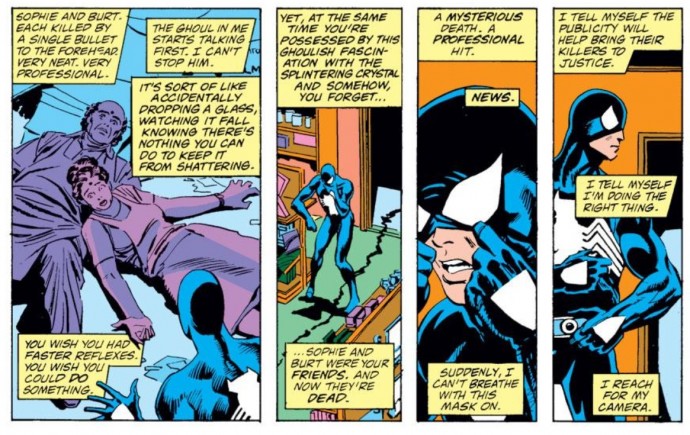
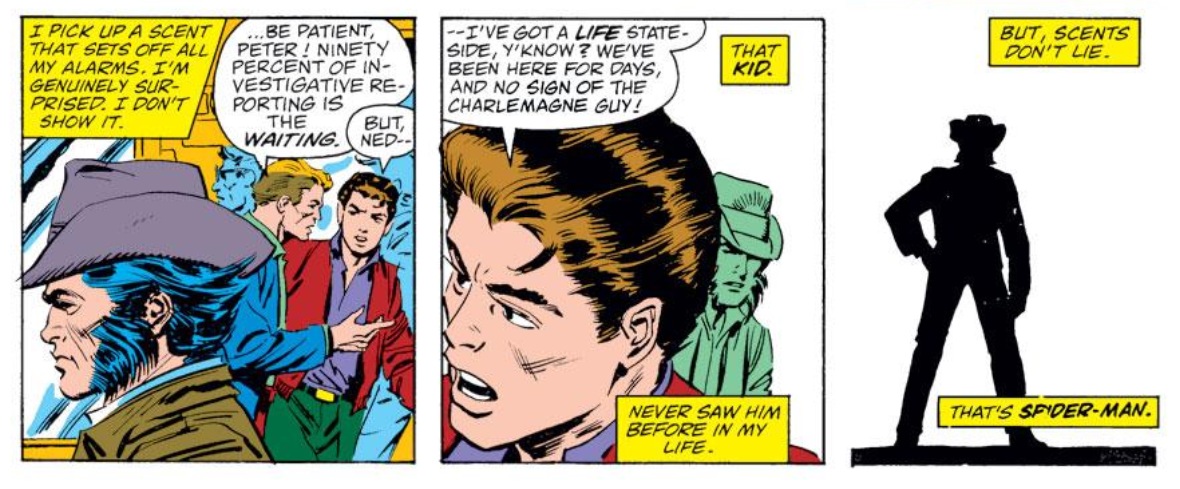
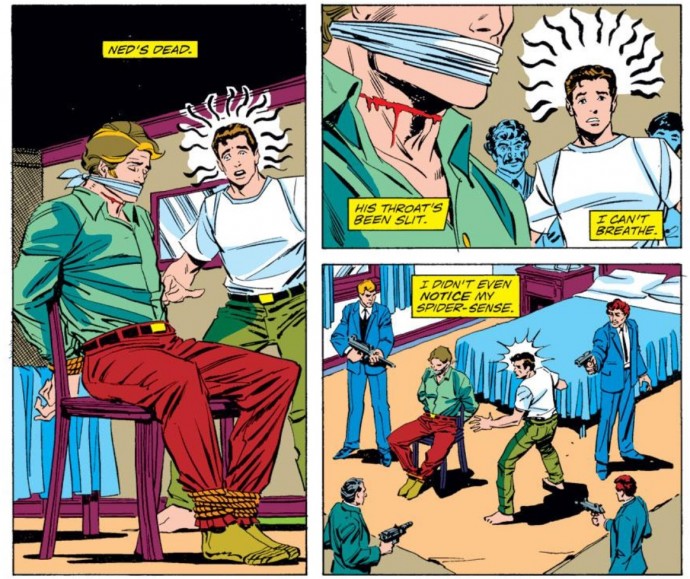
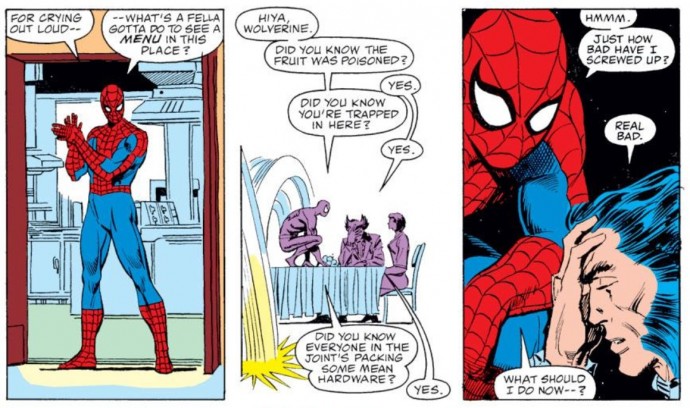
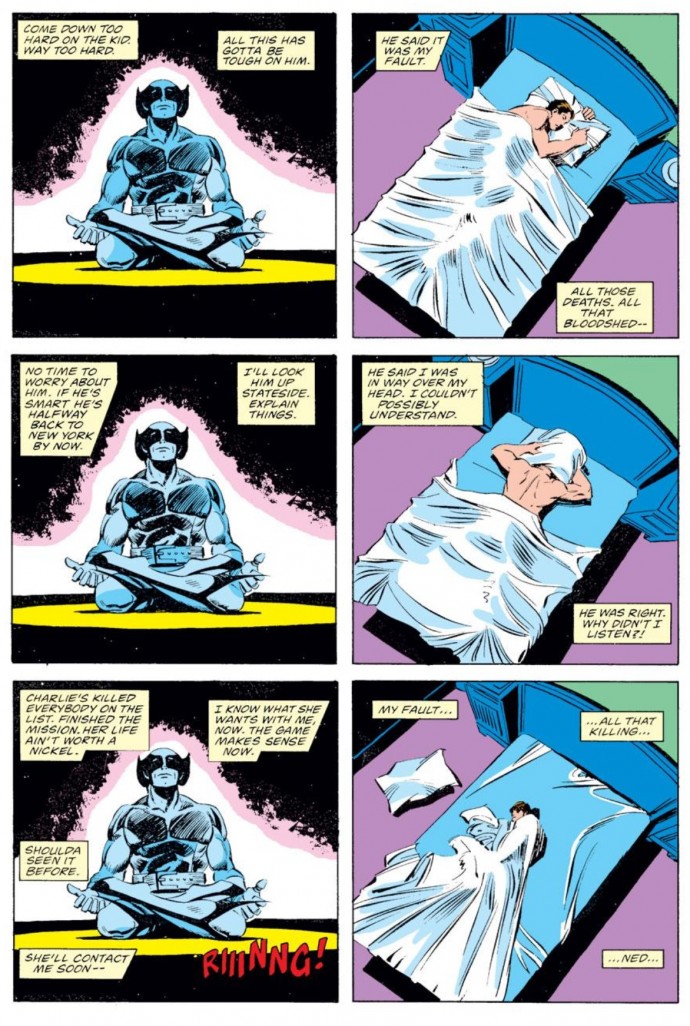
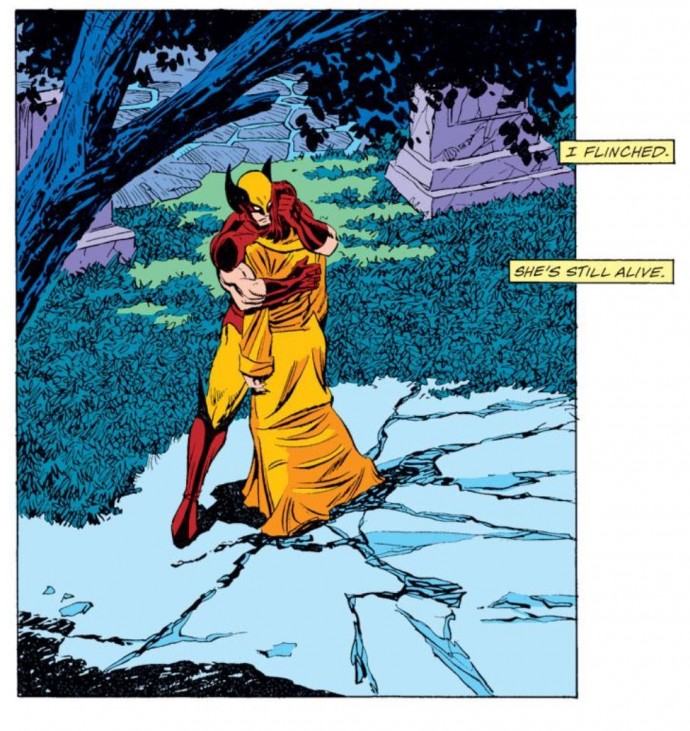
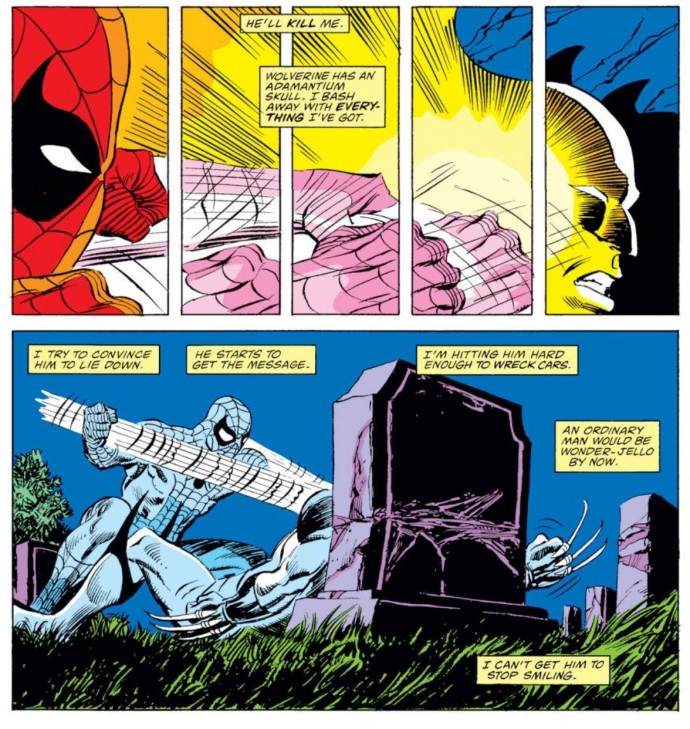
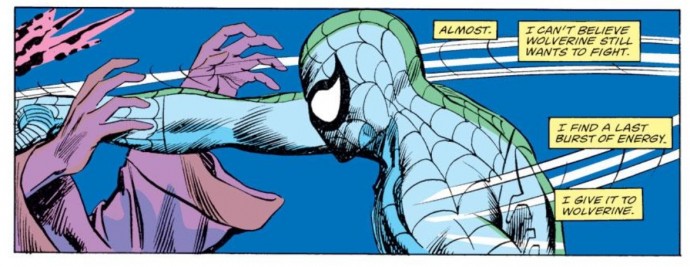


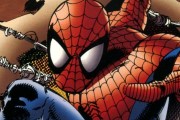
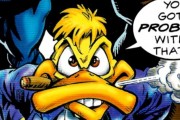
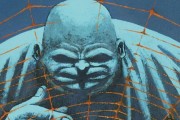
It’s been a long time since I read this so I can’t remember much of the story. It’s certainly quite a bold piece though I wonder how much of it was part of the struggles over the direction of Spider-Man – there’s a lot on the internet about disagreements between writers and editors that suggests a few things were written to assert control. Owsley/Priest has complained that one of the intentions of the book was to show why Peter and MJ couldn’t get married, yet a scene was subsequently taken out of the intended context and used to justify the reverse.
Inevitably, except in weeks like this, the main interest tends to be the death of Ned Leeds. Given his long term significance as well as being the prime suspect in the Hobgoblin saga it’s odd that he gets killed off in a side project when any Bugle reporter could have served the purpose.
Reports suggest he was axed because of the Hobgoblin assumptions, either to remove him from the picture or in order to undermine a writer assumed to be building up to revealing Leeds. The whole thing resulted in yet another writer on fill-in assignment having to wrap up a saga with all the mess of the earlier struggles and little more than his understanding of what was planned and the printed comics to work out a solution. But here Ned’s death is just utterly needless.